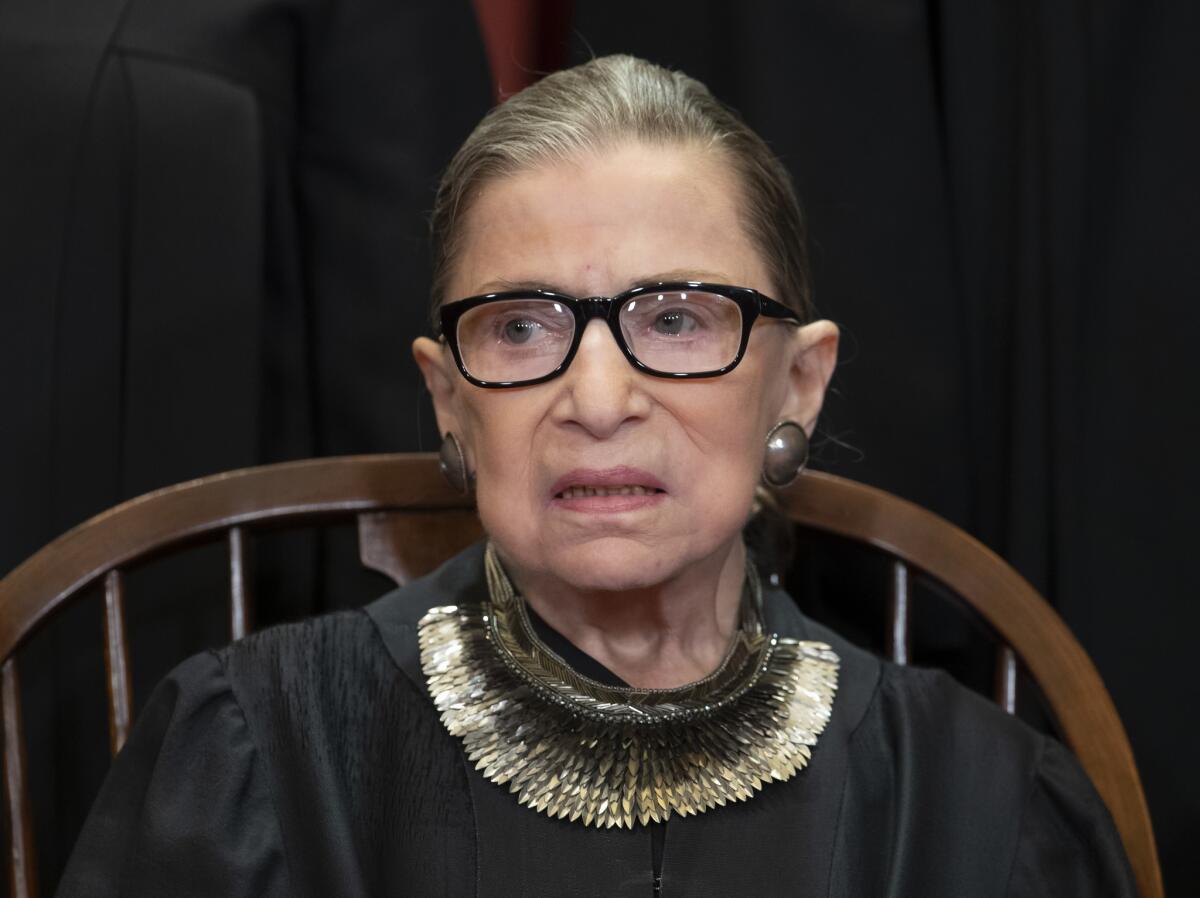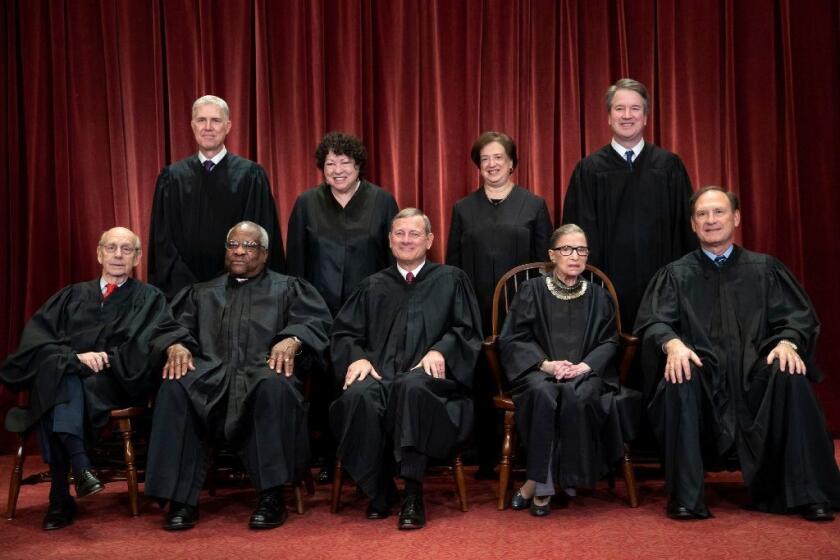How Ruth Bader Ginsburg and the Supreme Court could play a role in the presidential race

- Share via
It is a rare thing to have so many people be so attentive to the health and well-being of an 87-year-old they don’t know and have probably never met.
But Ruth Bader Ginsburg is no ordinary octogenarian. As the oldest member of the U.S. Supreme Court, and a stalwart of its liberal wing, the vitality of the jurist is of exceeding importance to those eager to fashion the nation’s highest court after their own views and ideology.
Every medical bulletin, like Ginsburg’s recent announcement she was undergoing chemotherapy for a recurrence of cancer, brings a fresh round of ghoulish speculation about a possible court vacancy, who might fill the seat, when and how.
While the Supreme Court is supremely important — and its makeup of utmost interest to a segment of the electorate — it has typically not been a top-of-the-mind issue for the vast majority of those casting presidential ballots.
Justice Ruth Bader Ginsburg was the second woman to serve on the Supreme Court and the first to become a pop culture icon.
Voters pay attention to major court decisions and political fights such as the 2018 battle over Brett M. Kavanaugh’s nomination, said Carroll Doherty, who directs political research for the nonpartisan Pew Research Center. But in general, he said, “Americans don’t know a lot about the court,” and their interest quickly wanes with the faded news headlines.
“They can see members of Congress. They can see the presidential candidates,” Doherty went on. “But you don’t see [Chief Justice] John Roberts on CNN. You don’t see the court’s deliberations in real time.”
A look at the major Supreme Court rulings of 2020, including on abortion, religion and immigration.
The level of voter interest could, however, change instantly.
A court vacancy this close to the Nov. 3 election — now less than 100 days away — would thrust the Supreme Court to the center of the presidential contest in a way unseen in modern times, heightening the stakes in what is already regarded as a pivotal election.
President Trump can’t fill a Supreme Court opening so close to the election, can he?
He could most certainly try. And he seems quite eager for the opportunity.
But didn’t Republicans hold a seat open for close to a year in 2016, awaiting the election returns?
They most certainly did. After conservative Justice Antonin Scalia died suddenly in February of that year, President Obama nominated Merrick Garland, a well-regarded appeals court judge, to fill his vacant seat.
But Senate Majority Leader Mitch McConnell said voters should have a say in replacing Scalia, and he declined to schedule a vote or even hold hearings on Garland’s nomination, which became moot when Trump was elected.
Those approaches seem completely contradictory.
If you want consistency, get yourself a copying machine.
So how does McConnell justify the turnabout?
The Kentucky Republican and other leading GOP lawmakers, including the Senate Judiciary Committee chairman, Lindsey Graham of South Carolina, say things are different this time because the White House and Senate are controlled by the same party.
Was the Supreme Court a big issue in 2016?
Not really — but that’s not to say the vacancy was unimportant to the outcome.
Come again?
In May 2016, Trump became the first presidential candidate to release a list of prospective Supreme Court nominees, which was more than a theoretical exercise given Scalia’s open seat. Drawing on recommendations from the Federalist Society and the Heritage Foundation, two redoubtable conservative groups, Trump’s move reassured many Republicans about his political bona fides and persuaded some who had doubts about the candidate’s character and other qualities to nevertheless support him.
(Trump selected one of those on his list, appeals court Judge Neil M. Gorsuch, to fill Scalia’s seat.)
In an election as close as the 2016 contest — which was essentially decided by fewer than 80,000 votes spread across Michigan, Pennsylvania and Wisconsin — one could point to any number of factors as being decisive. But clearly Trump benefited from his decision to name his prospective court nominees. A Pew exit poll found that 20% of voters considered the Supreme Court the most important factor in their decision, and of those, 56% supported Trump, compared with 41% who backed Democratic rival Hillary Rodham Clinton.
It seems like the court hasn’t been much of an issue this time, either.
No, though Trump would like to change that.
After the court issued a handful of rulings on abortion, gay rights and immigration that shocked and disappointed conservatives, the president tweeted that the “horrible and politically charged” decisions were “shotguns blasts into the face of people that are proud to call themselves Republicans or Conservatives.” He said the court’s action underscored the need to vote for his reelection and has promised he would release a new list of prospective Supreme Court nominees by Sept. 1.
Chief Justice Roberts sends a message that the Supreme Court is independent and not an ally of one party.
What has Trump’s Democratic rival, Joe Biden, said about his choices for the court?
Biden, a former chairman of the Senate Judiciary Committee, has taken a more traditional approach, speaking broadly about his criteria to fill any Supreme Court vacancies. He has, for instance, suggested he would only nominate someone he believed would uphold the legal right to abortion, a litmus test among Democrats.
So far, however, Biden has ignored entreaties that he release his own list of prospective nominees, though the former vice president has pledged to make history by appointing the first Black woman to the high court. He said he may reveal some possible choices before election day.
“We are putting together a list of a group of African American women who are qualified and have the experience to be on the court,” Biden said last month, but added, “I am not going to release that until we go further down the line in vetting them, as well.”
Ginsburg isn’t the only justice of ripe vintage, is she?
That is true. Stephen G. Breyer, of the court’s moderate-to-liberal wing, is 81. Conservative Justices Clarence Thomas and Samuel A. Alito Jr. are 72 and 70, respectively.
The actuarial tables suggest the next president will have the opportunity to fill at least one and possibly more openings, potentially shaping the outcome of high court decisions, major and minor, for years to come.
Speaking of major rulings, didn’t the Supreme Court once say you can’t hurry love?
No. That was Diana Ross and the Supremes.
Ah. Never mind.
More to Read
Get the L.A. Times Politics newsletter
Deeply reported insights into legislation, politics and policy from Sacramento, Washington and beyond. In your inbox twice per week.
You may occasionally receive promotional content from the Los Angeles Times.














